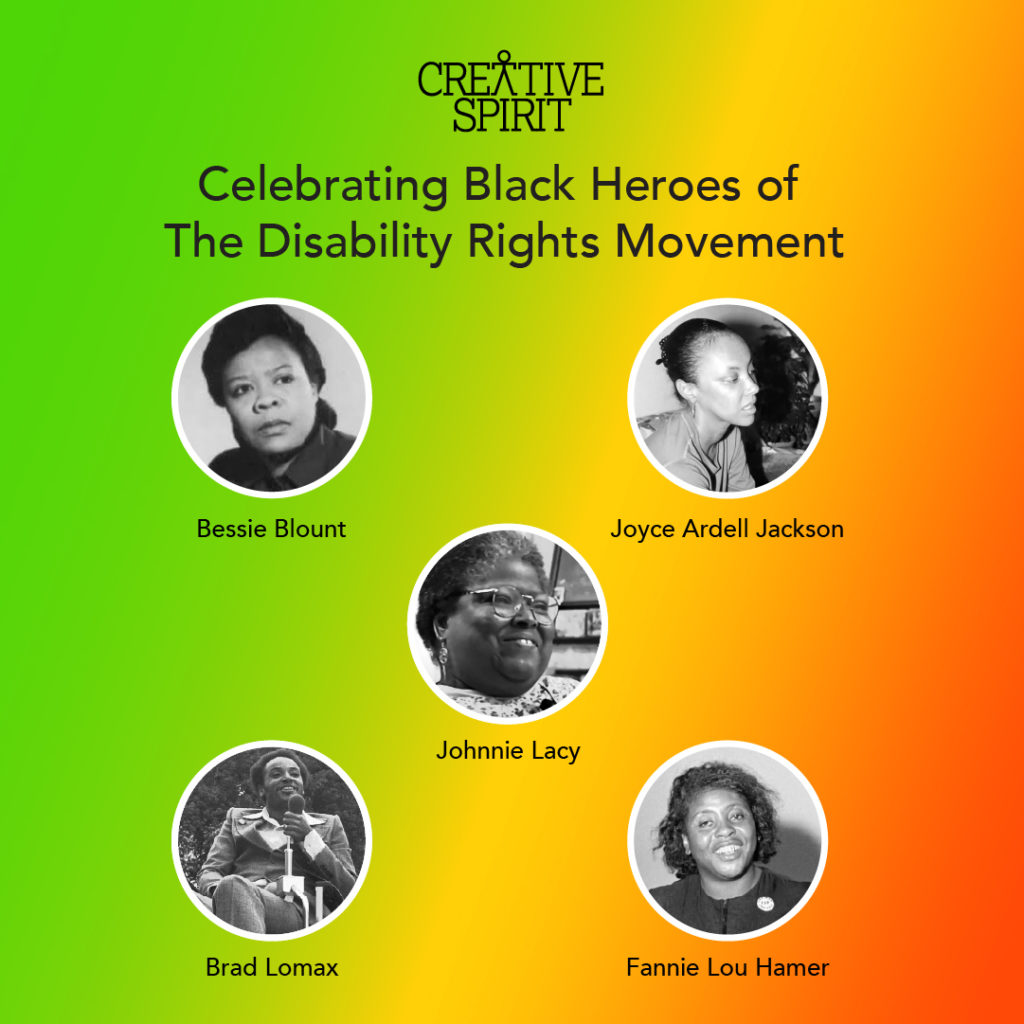By: Menachem Rephun, Creative Spirit Communication Manager

February is Black History Month, which celebrates black heroes contributions, triumphs, and achievements throughout U.S. history. One aspect of Black History Month that has been less explored is the significant, historical contribution made by African-Americans to the disability rights movement, which promotes equity and inclusion for the millions of Americans with disabilities. In this article, we’ll be profiling five African-American activists and civil rights leaders who have had a lasting impact on disability rights.
Bessie Blount
Assistive technologies, such as large print materials, Braille displays, clothing aids, alternative input devices, and more, have made a huge difference for people with disabilities over the past several decades. One major pioneer and innovator in this field was Bessie Blount (November 24, 1914 – December 30, 2009), an African-American writer, nurse, physical therapist, inventor, and forensic scientist. Born in Hickory, Virginia, where she attended a segregated school, Blount began her career as a physical therapist, helping WWII veterans who had lost their hands and feet develop new ways of performing basic tasks. To help these veterans regain their ability to feed themselves independently, Blount invented an electric self-feeding apparatus consisting of a tube that patients could bite down on, delivering individual bites of food to the mouthpiece. While teaching at New York’s Bronx Hospital Blount would expand this invention further, patenting a neck brace with built-in support for bowls, cups, and dishes. Unfortunately, as Lemelson Mit.edu notes, the American Veterans Association was largely indifferent to Blount’s innovations, despite their enormous potential to improve the quality of life for countless disabled veterans. Rather than being discouraged, Blount licensed her invention freely to the French government in 1952. According to Lemelson.edu, Blount said that her innovations proved “that a black woman can invent something for the benefit of humankind.” Blount, who passed away in 2009 at 95, was well-known in the inventor community and developed a close friendship with Theodore Edison, son of famed inventor Thomas Edison. Her original disposable cardboard emesis basin design is still used in Belgian hospitals nationwide. Through her work, Blount represented and enhanced respect and appreciation for the dignity, independence, and humanity of people with disabilities. Her ingenuity, determination, and innovative thinking all continue to serve as an inspiration for the disability rights movement today. On to more black heroes.
Johnnie Lacy
Living independently is something most people take for granted, but for many people with disabilities it still often presents challenges. Johnnie Lacy (1937 – 2010) was a disability rights advocate and champion of the independent living movement, which views disability as a societal construct, rather than a problem with the individual that needs to be solved. After contracting polio at 19 while working on her nursing degree, Lacy became paralyzed and reliant on a wheelchair. While studying speech-language pathology at San Francisco State University, Lacy encountered barriers to higher education, such as not being allowed to participate in graduation ceremonies and the head of the speech therapy department attempting to block her enrollment. “My final and departing shot to him was that if I were just a woman, he could not do this to me,” Lacy said, according to Independence Now.org. “If I were only a person of color, he would not be able to do this to me; the only way you can take this unfair advantage is because I have a disability.” Spurred on by these experiences, Lacy co-founded the Berkeley Center for Independent Living, leading to her position as Executive Director for the Community Resources for Independent Living (CRIL) in Hayward, California. A tireless campaigner on behalf of independence for people with disabilities, Lacy raised $350,000 to build the CRIL Center in Hayward, completing the project in 1984. Lacy’s leadership improved access for Black people with disabilities to services that had been predominantly white-led. Today, there are 28 Independent Living Centers in California and over 200 in the United States. Lacy passed away in 2010 at 73, but her legacy of championing inclusion, accessibility, and independence for people with disabilities continues to live on. On to more black heroes.
Fannie Lou Hamer
Fannie Lou Hamer (October 6, 1917 – March 14, 1977) was one of the most legendary figures in the Civil Rights movement of the 1960s. Her name is synonymous with the fight for justice and equality for African-Americans all marginalized communities. Born to a sharecropping family in Montgomery County, Mississippi, Hamer experienced physical disability throughout her life, including a broken leg from being dropped as a baby that was never set, a forced hysterectomy in 1961 (a form of medical malpractice commonly inflicted on Black women in Mississippi at that time), and permanent disability from being beaten in a Mississippi jailhouse in 1963 while fighting for civil rights. Hamer’s awakening to the cause of civil rights for African-Americans occurred in 1962, when Student Non-Violent Coordinating Committee (SNCC) volunteers held a voter registration meeting in Montgomery. Before that point, Hamer was unaware that Black people had a constitutional right to vote. Demonstrating her courage, Hamer volunteered to go to the courthouse to register to vote. This decision resulted in beatings, death threats, and assassination attempts.
Undeterred, Hamer became an SNCC Field Secretary, traveling nationwide to ensure voter registration for Black Americans. Her long list of achievements includes, but is not limited to, organizing a strike for Black cotton pickers; working as a field organizer for the Student Non-Violent Coordinating Committee (SNCC); working with the National Council of Negro Women to create farm cooperatives and banks that would improve food access for poor residents; helping to establish the National Women’s Political Caucus; co-founding the Mississippi Freedom Democratic Party (MFDP), for which she coined the famous slogan “We are Sick and Tired of Being Sick and Tired”; and perhaps most notably, ensuring that African-Americans were registered to vote by leading the 1964 Mississippi Freedom Summer campaign. This effort cost Hamer her job and resulted in harassment and violent physical assault. Hamer has become synonymous with courage and resilience in the face of injustice through her work. She powerfully stated, “Nobody’s free until everybody’s free.” For Black History Month, we’re honoring Fannie Lou Hamer’s legacy and her embodiment of the fact that there’s no limit to what people with disabilities can accomplish. On to more black heroes.
Brad Lomax
Brad Lomax (September 13, 1950 – August 28, 1984) was a member of the Black Panther party and a leading figure in the disability rights movement in the late 1960s and early 1970s. He is best known for his involvement in the “504 sit-ins” in 1977 to pressure the U.S. government to implement Section 504 of the 1973 Rehabilitation Act, which would protect people with disabilities from unlawful discrimination. Born in Philadelphia in 1950, Lomax was diagnosed with multiple sclerosis while attending Howard University, and eventually began using a wheelchair as the disease progressed. While living in Oakland, California, Lomax experienced the severely limited physical accessibility for people with disabilities, especially in public transportation. According to a retrospective on Lomax’s life by the NY Times, Lomax’s brother Glenn would have to lift Lomax out of his wheelchair and place him in his seat in order to board the bus. Lomax also realized that people with disabilities, especially African-Americans, were being routinely excluded from educational opportunities, along with a shortage of services to help them find housing and employment. This awareness inspired Lomax to become more heavily involved in the disability rights movement. After learning about the Center for Independent Living (CIL), Lomax met with CIL director Ed Roberts and suggested founding the East Oakland CIL.
In 1977, Lomax joined over 100 people in occupying the fourth floor of the San Francisco Federal Building’s Department of Health, Education, and Welfare (HEW). This month-long demonstration, later known as the “504 Sit-In”, would become the longest peaceful occupation of a federal building in U.S. history. The demonstrators were met with resistance from the government, which shut off the water supply and telephone lines. Three weeks later, Lomax and 25 demonstrators traveled to pressure H.E.W. secretary Joseph A. Califano, whom they felt had been dragging his feet, to sign the regulations implementing Section 504. Their efforts were successful. On April 28, 1977, the regulations were signed, ensuring the enactment of Section 504 and laying the groundwork for the Americans With Disabilities Act (ADA), an even more significant and historic piece of legislation that transformed accessibility and inclusion for people with disabilities. Sadly, Lomax did not live to see the passage of the ADA. He passed away on Aug. 28, 1984, at just 33, of complications from multiple sclerosis. Today, his legacy and impact can still be felt through improvements in accessibility and inclusion for millions of Americans with disabilities. On to more black heroes.
Joyce Ardell Jackson
Brad Lomax was not the only notable disability rights activist in the “504” Sit-In. Joyce Ardell Jackson (1947-2013), a lifelong campaigner for people with disabilities, was diagnosed with juvenile rheumatoid arthritis at age 12, enduring over 50 operations throughout her life. Determined not to be held back by her disability, Jackson held numerous jobs after graduating from Santa Clara University in 1973, including positions with McDonnell Douglas, British Telecommunications, and the San Jose Mercury News. As a participant in the “504” Sit-In, Jackson arranged meetings between the demonstrators and then-President Jimmy Carter, ultimately leading to the passage of Section 504. She would go on to serve three terms on the American Coalition of Citizens With Disabilities board, and traveled around the country to let people know about Section 504. Following her involvement in the “504” Sit-In, Jackson continued to work as a disability rights counselor for nonprofits, along with working in the private sector as a telecommunications support representative. Throughout her life, Jackson demonstrated resilience, courage, and determination to succeed and remain independent despite her disability. These values and strengths continue to drive the disability rights movement today.
The black heroes and activists and civil rights leaders featured on this list are only a handful of the many Black Americans who have been at the forefront of the disability rights movement, championing accessibility, fighting discrimination, and above all, sharing the powerful message that society cannot be considered equal unless people with disabilities are fully included. As we celebrate Black History Month, it’s both important and inspiring to reflect on these individuals who refused to be held back by adversity, and whose impact still reverberates just as strongly today as it did many decades ago.






